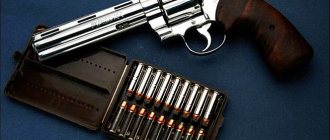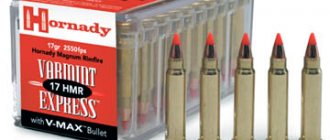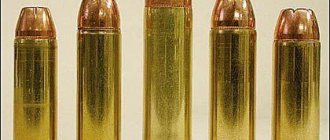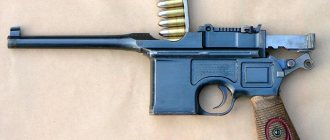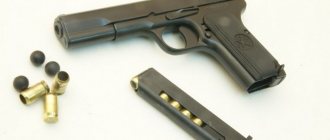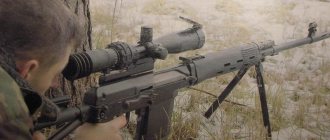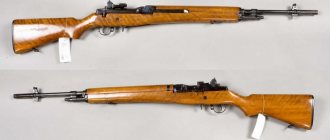Design and technical characteristics [edit]
The .416 Rigby case is one of the highest volume cases and was originally designed to use cordite strands as a propellant.
The large body allowed the .416 Rigby to operate at moderate pressures while still delivering good performance in terms of velocity and energy. The .416 Rigby was intended for use in Africa and India. Because cordite was subject to large variations in chamber pressure depending on ambient temperature, the relatively moderate pressure load of the .416 Rigby provided a safety margin against dangerously high pressure levels when used in tropical regions. Diagram of the .416 Rigby CIP Compliant Cartridge
: All dimensions are in millimeters [inches].
The dimensions and specifications of the .416 Rigby are regulated by CIP. CIP specifies a 6 flute barrel with a bore diameter of 10.36 mm (0.408 in) and a flute diameter of 10.57 mm (0.416 in) with each flute 3.60 mm (0.142 in) wide and a twist rate of 420 mm (1-16. 53 inches). The beginning of the rifling should start at 7.62 mm (0.300 in). The maximum average pressure specified by CIP is 325.00 MPa (47,137 psi) for this cartridge.
SAAMI has listed the .416 Rigby cartridge, and there are no discrepancies between SAAMI and CIP regarding case characteristics and chamber dimensions for the .416 Rigby cartridge. The maximum average pressure specified by SAAMI is 358.53 MPa (52,000 psi). Most U.S. ammunition manufacturers offer the .416 Rigby for dangerous game hunting, and the cartridge is becoming popular again.
Links[edit]
- .416 Rigby data from Federal Premium Ammunition
- Helsley, Steve. "Rigby Celebrates 275 Years", in Safari: The Journal of Big Game Hunters
, Safari Club International, November–December 2009, p. 27. - ↑
Coogan, Joe (October 2002). "The .416 Rigby: Just Enough," American Rifleman, p. 80
- John Rigby & Co. (Gunmakers) Ltd. London, England (recent website)
- John Rigby (Gunmaker's) Ltd. London, England (archived website)
- TDCC (cartridge size and specification tables) - information, database query, downloads (CIP)
Origin and history[edit]
Two important events at the turn of the 20th century began the development of the .416 Rigby as a successful big game hunting cartridge. The first was the development of cordite in Great Britain in 1889, and the second was the development of the Magnum Mauser 98 action, based on the Gewehr 98 bolt-action repeating rifle developed in Germany.
Before the invention of cordite, rifles used gunpowder (black powder) as fuel. Because black powder burned slowly, it did not produce high pressures and therefore did not produce the high speeds needed to take large, thick-skinned game such as cape buffalo, rhinoceros, and elephant. The development of smokeless powder revolutionized the rifle. One version of this smokeless powder, Cordite, allowed for higher pressures, thereby increasing the velocity and performance of rifle cartridges.
The next improvement was Paul Mauser's development of the Gewehr 98 rifle. Paul Mauser did not invent the bolt-action rifle, but rather he improved the design to allow for controlled cartridge feeding, a quick-loading puller, and a powerful bolt to withstand the high pressures created by the new smokeless rifles. gunpowder. The rifle design would go on to become the most common and successful rifle design in firearms history. During World War II, most Axis and Allied countries, with the exception of the British (Lee-Enfield) and Russians (Mosin-Nagant), used rifles based on the Mauser 98 action. Today it is still the most popular rifle design used by Heym, Holland & Holland, Mauser, Rigby, Westley Richards, Winchester and several other gun manufacturers. The Mauser 98 action provided consumers and gun manufacturers with a low-cost alternative to the double-barreled and single-shot rifles that had dominated dangerous game hunting until that time.
At the turn of the 20th century, four major British rifle manufacturers, Holland & Holland, John Rigby & Co., W. J. Jeffery & Co. and Westley Richards, developed cartridges that could chamber the Magnum Mauser 98 action and could offer large caliber nitro-express cartridges . the ballistics and performance of a repeating rifle, which the British called their bolt-action rifles. The result was the medium caliber big game cartridges .375 H&H Magnum, .416 Rigby, .404 Jeffery, and .425 Westley Richards. The in-game performance of these cartridges was consistent with the larger bore Nitro Express cartridges. The characteristics of these cartridges were driven by sectional density (over 7.6 mm (0.300 in)) and higher velocity (~700 m/s (2,300 ft/s)).
The first .416 Rigby rifles used the Magnum Mauser 98 Square Bridge No. action. 5. Large slide and slide length Magnum Mauser 98 No. 5 cartridges were easily adapted for use with the .416 Rigby cartridge. As the Magnum Mauser 98 action became rarer after World War II, .416 Rigby rifles were built on the Enfield P-17 and BRNO. The Enfield P-17 and BRNO actions are in turn based on the Magnum Mauser 98 rifle.
After World War II, with fewer areas available for hunting dangerous game, interest in the .416 Rigby and most large bore Nitro Express cartridges began to wane. By 1970, with the demise of British ammunition supplier Kynoch as an entity, the supply of .416 Rigby ammunition dwindled, and many hunters including Selby put aside their .416 Rigby rifles in favor of the more popular .375 H&H Magnum. 458 Winchester Magnum and .458 Lott.
From 1912 until the outbreak of World War II John Rigby & Co. produced 169 Rigby rifles in .416 caliber and 180 rifles between 1939 and 1984. From 1984 when Paul Roberts took over John Rigby & Co. and 1997 when the company was acquired by Geoff. Miller produced another 184 rifles. Only after Bill Ruger of Sturm, Ruger & Co. began offering the Ruger Model 77 RSM Magnum Mk II in 1991, the cartridge finally became popular. Ruger produced approximately 1,000 rifles between 1991 and 2001, greatly increasing the number of .416 Rigby rifles in circulation. [ citation needed
]
With renewed interest in dangerous game hunting in Africa, demand for big game ammunition has increased. Major ammunition manufacturers such as Norma, Federal, and Hornady began producing .416 Rigby ammunition to meet the new demand. The Kynoch brand was licensed to Eley by Kynamco, a British ammunition manufacturer based in Suffolk, England, which continues to manufacture .416 Rigby ammunition under the Kynoch brand. [ citation needed
]
Performance[edit]
The original ammunition for the .416 Rigby used cordite as the propellant charge, firing an all-metal jacket or 27 gr (410 g) round-nose soft-tip bullet at 700 m/s (2,300 ft/s), generating 6,375 J (4,702 ft). ⋅lbf). The current standard for smokeless powder use is a 26 g (400 g) bullet at 730 m/s (2,400 ft/s) generating 6,935 J (5.115 ft⋅lbf). This is the standard to which Federal, Hornady, Nosler and Winchester load their ammunition. In its original configuration, the .416 Rigby compares favorably with its closest cousins of the era: the .404 Jeffery and .425 Westley Richards. The .416 Rigby is loaded with a 26 gr (400 g) bullet at 736 m/s (2,415 ft/s) like Hornady Russian DGS and DGX ammunition has an MPBR of 181 m (198 yd). The cartridge is capable of producing over 5,400 J (4,000 ft⋅lbf) of energy at a range of 100 m (110 yd). By comparison, a typical .458 Winchester Magnum firing a 32 gr (500 g) bullet at 620 m/s (2,050 ft/s) is held above 5,400 J (4,000 ft lbf) just after 46 m ( 50 yards). ) mark.
Since the late 1980s, several .416 cartridges have appeared on the market. Among them, the .416 Remington Magnum, .416 Ruger, and .416 Weatherby Magnum have received the most attention from the firearms press. [ citation needed
]The Remington and Ruger cartridges were designed to fire a 26 gr (400 g) bullet at over 730 m/s (2,400 ft/s) to emulate the level of performance of the .416 Rigby. When loaded to the appropriate maximum average pressure level, Rigby and Remington cartridges are capable of driving a 26 g (400 g) bullet at over 760 m/s (2,500 ft/s). However, the Rigby cartridge is loaded to a relatively low maximum allowable pressure of 325 MPa (47,100 psi), while the Remington cartridge has a specified maximum average pressure of 430 MPa (62,000 psi). The .416 Remington Magnum case capacity is about 82% that of the .416 Rigby. The larger body of the .416 Rigby allows the cartridge to generate the same velocity and energy as the .416 Remington Magnum, but does so at much lower pressure levels. Unlike Remington and Rigby cartridges, the .416 Ruger cartridge, due to its case having an even lower capacity than the Remington, operates at nearly the maximum allowable pressure, mimicking the factory ammunition performance of Rigby and Remington cartridges. The .416 Wetherby Magnum, which uses a similar sized case as the Rigby, is capable of launching the same bullet at 820 m/s (2,700 ft/s).
Excerpt describing .416 Rigby
“I don’t... please, your Excellency,” said Prince Andrei quietly. Arakcheev's eyes turned to him. “Sit down,” said Arakcheev, “Prince Bolkonsky?” “I’m not asking for anything, but the Emperor deigned to forward the note I submitted to your Excellency...” “Please see, my dear, I read your note,” Arakcheev interrupted, only saying the first words affectionately, again without looking him in the face and becoming more and more depressed. and more in a grumpily contemptuous tone. – Are you proposing new military laws? There are many laws, and there is no one to enforce the old ones. Nowadays all laws are written; it is easier to write than to do. “I came by the will of the Emperor to find out from your Excellency what course you intend to give to the submitted note?” - Prince Andrey said politely. “I have added a resolution to your note and forwarded it to the committee.” “I don’t approve,” said Arakcheev, getting up and taking a paper from the desk. - Here! – he handed it to Prince Andrey. On the paper across it, in pencil, without capital letters, without spelling, without punctuation, was written: “unfoundedly composed as an imitation copied from the French military regulations and from the military article without the need of retreating.” – Which committee was the note sent to? - asked Prince Andrei. - To the committee on military regulations, and I submitted a proposal to enroll your honor as a member. Just no salary. Prince Andrei smiled. - I don’t want to. “Without a salary as a member,” Arakcheev repeated. - I have the honor. Hey, call me! Who else? - he shouted, bowing to Prince Andrei. While awaiting notification of his enrollment as a member of the committee, Prince Andrei renewed old acquaintances, especially with those persons who, he knew, were in force and could be needed by him. He now experienced in St. Petersburg a feeling similar to what he had experienced on the eve of the battle, when he was tormented by a restless curiosity and irresistibly drawn to higher spheres, to where the future was being prepared, on which the fate of millions depended. He felt from the embitterment of the old people, from the curiosity of the uninitiated, from the restraint of the initiated, from the haste and concern of everyone, from the countless number of committees, commissions, the existence of which he learned again every day, that now, in 1809, was being prepared here in St. Petersburg, some kind of huge civil battle, the commander-in-chief of which was a person unknown to him, mysterious and who seemed to him a genius - Speransky. And the most vaguely known matter of transformation, and Speransky, the main figure, began to interest him so passionately that the matter of military regulations very soon began to pass into a secondary place in his mind. Prince Andrei was in one of the most favorable positions to be well received into all the most diverse and highest circles of the then St. Petersburg society. The party of reformers cordially received and lured him, firstly because he had a reputation for intelligence and great reading, and secondly because by his release of the peasants he had already made himself a reputation as a liberal. The party of dissatisfied old men, just like their father’s son, turned to him for sympathy, condemning the reforms. Women's society, society, welcomed him cordially, because he was a groom, rich and noble, and almost a new face with the aura of a romantic story about his imaginary death and the tragic death of his wife. In addition, the general voice about him from everyone who knew him before was that he had changed a lot for the better in these five years, had softened and matured, that there was no former pretense, pride and mockery in him, and there was that calmness that purchased over the years. They started talking about him, they were interested in him and everyone wanted to see him.
As a parent cartridge[edit]
The .416 Rigby case has a unique design in that it did not have a case acting as a parent cartridge during its development. Because of its case volume, the .416 Rigby case has become the primary cartridge for several modern cartridges and has served as the inspiration for many others. The .378 Weatherby Magnum family of cartridges, which includes the .30-378, .338-378, .378, .416 and .460 Weatherby Magnums, uses a case similar to the .416 Rigby cartridges, but with a belt added to the case design . .
The .416 Rigby cartridge is the parent cartridge to the following cartridges:
.300 Lapua Magnum[edit]
The .300 Lapua Magnum cartridge was developed by Lapua of Finland, using the case of the .338 Lapua Magnum, which in turn was based on the .416 Rigby. Lapua does not manufacture ammunition for this cartridge and it should be considered a dry cartridge.
.338 Lapua Magnum[edit]
The 0.338 Lapua Magnum cartridge is a redesign of Lapua from the predecessor level developed by Research Armaments Industries (RAI) and Brass Extrusion Labs Ltd. (BELL), known as .338/416. The Lapua uses a modified .416 case, shortened and tapered to accept an 8.59 millimeter (0.338 in) bullet. The cartridge is capable of firing a 15.0 g (231 g) bullet at a velocity of 920 m/s (3,000 ft/s).
.450 Dakota [edit]
The .450 Dakota was developed by Don Allen Dakota Arms. It is virtually identical to the .450 Rigby cartridge, which came out a few years earlier. The cartridge is based on the .416 Rigby cartridge with a neck of up to 11.6 mm (0.458 in). The .450 Dakota fires a 32 gr (500 g) bullet at 780 m/s (2,550 ft/s).
.450 Rigby[edit]
The .450 Rigby was developed by Paul Roberts John Rigby & Company. The cartridge was designed to fire a 31 g (480 g) bullet at a velocity of 725 m/s (2,378 ft/s).
.510 Whisper[edit]
The .510 Whisper is a subsonic rifle cartridge developed by SSK Industries for use in suppressed rifles, with a noise similar to a .22 short. [2] It fires a 750 gr (49 g) .51 caliber bullet at approximately 1,050 ft/s (320 m/s).
